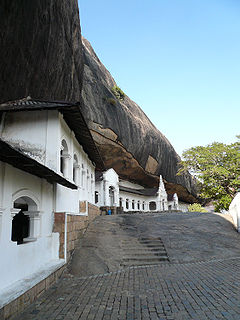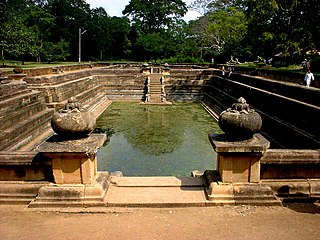The expulsion of the Muslims from the Northern province was an act of ethnic cleansing carried out by the Tamil militant Liberation Tigers of Tamil Eelam (LTTE) organisation in October 1990. Due to increasing tensions between the Muslims (Moors) and Tamils in the North Sri Lanka and the Muslim opposition to the creation of a Tamil homeland, the LTTE forcibly expelled the 72,000 strong Muslim population from the Northern Province.
Asian Highway 43 (AH43) is a route of the Asian Highway Network, running 3,024 kilometres (1,879 mi) from Asian Highway 1 in Agra, India to Matara in Sri Lanka.
Eelam War III is the name given to the third phase of armed conflict between Sri Lankan military and the separatist Liberation Tigers of Tamil Eelam. After the period of 100 days cease-fire the hostilities broke out on 19 April 1995. The LTTE - Sea Tigers planted explosives in two gun boats known as SLNS 'Sooraya' and 'Ranasuru', and blew them up. Also, a new weapon "Stinger", a shoulder-launched anti-aircraft missile was used in this conflict by the LTTE. This was used to take down two Sri Lankan Air Force AVRO aircraft flying over the Jaffna peninsula. Eelam War III also marked the rising success of the LTTE, as they managed to capture key districts such as Kilinochchi and Mullaitivu, and took over the Elephant Pass base. By the end of Eelam War III, the LTTE had control of nearly 30% of the entire island.
The Second Battle of Elephant Pass, was a battle fought in April 2000 for the control of the Sri Lankan military base in Elephant Pass, Jaffna.
The Battle for the A-9 highway was fought in March and April 2000 for the control of the Sri Lankan A-9 highway.
The Battle of Kilinochchi was a battle that occurred in September 1998 for the control of the city of Kilinochchi in Sri Lanka. The battle was fought between the Sri Lankan Army (SLA) and the Liberation Tigers of Tamil Eelam (LTTE).
The 2008–2009 SLA Northern offensive was an armed conflict in the northern Province of Sri Lanka between the military of Sri Lanka and the separatist Liberation Tigers of Tamil Eelam (LTTE). The battle broke with the Sri Lanka Army (SLA) offensive attempting to break through the LTTE defence lines in the north of the island, aiming to conclude the country's 25-year-old civil war by military victory.
Operation Jayasikurui, was a Sri Lankan military action launched on 13 May 1997; it lasted until it was called off in 1999. The primary objective of this operation was to clear a land route to the government-held Jaffna peninsula through territory held by the LTTE, by linking the government-held towns of Vavuniya and Kilinochchi. At the time it was the largest military operation undertaken by the Sri Lankan military. Initially, the Sri Lankan military experienced success by forcing the LTTE out of Killinochchi, capturing vast areas, however the LTTE managed to launch a brutal counter-attack which reversed all gains made by the government. After failing to achieve their original objective, the Sri Lankan Army called off its operation.

Velayuthapillai Baheerathakumar was a leading member of the Liberation Tigers of Tamil Eelam (LTTE), a separatist Tamil militant organisation in Sri Lanka. He played a leading role in the LTTE's military victories in the Vanni during Eelam War III, including Mullaitivu (1996), Kilinochchi (1998), Oddusuddan (1999) and Elephant Pass (2000). He was killed at the Battle of Ananthapuram in the last days of the Sri Lankan Civil War.

The Battle of Kilinochchi was a land battle fought between the Sri Lankan Military and the Liberation Tigers of Tamil Eelam (LTTE) for the control of the town of Kilinochchi in the Northern Theater of Eelam War IV during the Sri Lankan civil war between November 2008 and January 2009. The town of Kilinochchi was the administrative center and de facto capital of the LTTE's proposed state of Tamil Eelam.

Yal Devi is a major express train in Sri Lanka. Operated by Sri Lanka Railways, the Yal Devi connects Colombo, the nation's commercial hub, with the northern cities of Jaffna and Kankesanturai. From 1990 up to 2015, the service had to terminate at intermediate stations, due to the Sri Lankan civil war. The Northern Line was rebuilt and returned to Jaffna Railway Station by October 2014 and Kankesanturai by January 2015.

Jaffna railway station is a railway station in the city of Jaffna in northern Sri Lanka. Owned by Sri Lanka Railways, the state-owned railway operator, the station is one of the busiest in the country, linking the north with the capital Colombo.

The northern line is a railway line in Sri Lanka. Branching off the Main Line at Polgahawela Junction the line heads north through North Western, North Central and Northern provinces before terminating at the northern port of Kankesanthurai. The line is 339 kilometres (211 mi) long and has 55 stations between Polgahawela Junction and Vavuniya. It is the longest railway line in Sri Lanka. The line opened in 1894. Major cities served by the line include Kurunegala, Anuradhapura, Vavuniya and Jaffna. The popular Yal Devi service operates on the line. The line was severely affected by the civil war and no services operated north of Vavuniya after 1990. Reconstruction of this section of the line commenced following the end of the civil war in 2009 and was fully completed in early 2015.

Yakkala is a township located on Colombo-Kandy Highway (A1), 30 km away from Colombo, Sri Lanka. It forms part of Gampaha Municipal Council and belongs to Gampaha District, Western Province. Its elevation is 30m above MSL. Distances from Yakkala to main cities are; 30 km to Colombo(A1), 86 km to Kandy(A1), 4.5 km to Gampaha(A33) and 13 km to Radawana(B479).

Chunnakam Power Station was a thermal power station in Chunnakam in northern Sri Lanka. Commissioned in 1958, the station is owned and operated by the state-owned Ceylon Electricity Board (CEB). It was decommissioned in 2013, and replaced by the Uthuru Janani Power Station, which is constructed less than 100m south of the Chunnakam Power Station.















